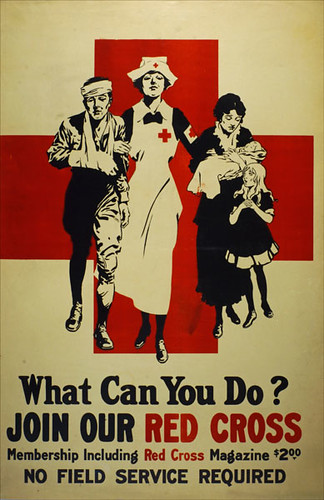As part of the ongoing exhibit of posters in Special Collections for Veterans Day, the students who created the exhibits also created entries for this blog. We will be posting these over the rest of the month of November.
1992.004.5.81
Title: What Can You Do? Join Our Red Cross. Membership Including Red Cross Magazine $2.00. No Field Service Required.
Artist/ Publisher: Unknown
Date: 1910-1920
Country of Origin: American
Dimensions: 106.2 x 71.2 cm
During World War I, the need for nurses grew exponentially. The battles being fought left many dead or wounded and the war required nurses to care for these soldiers. The Red Cross was the most essential organization to keeping the troops alive and with the many dead or dying there was a need for more nurses to care for the growing number in need of a nurse’s care. The poster in the Red Cross collection that illustrates their plea for help that I have chosen is titled “What Can You Do? Join Our Red Cross. Membership Including Red Cross Magazine $2.00. No Field Service Required”.
This poster initially proposes that they need help and the reader is just the person they are looking for. Then it goes on to reveal two incentives for the reader to participate. The audience has the opportunity to not only become a member of the Red Cross, but with that membership comes access to Red Cross magazine for the small sum of $2.00. If that was not at all enticing, the Red Cross poster also promises that, in addition to helping the Red Cross in their valiant effort to save all of the wounded soldiers and being able to read the Red Cross magazine, you will not have to put your life at risk while working in the field. Seeing as how the main Red Cross representative on the poster is a woman and that only women were nurses during that time, it is obvious that this poster’s message is geared towards women. The way the nurse in the middle holds herself suggests that she is proud of her ability to heal, as one should be. But the way she regards the wounded man to the left and the lonely mother with two children on the right adds to the feeling of the nurse being proud. It also seems as though it is supposed to be assumed she is leading them to safety, however it feels like she is offering them up to the audience. It looks as if she is showing the audience the opportunities they would have if they joined the Red Cross. They would be able to help the wounded and counsel those left behind from the tragedies of war.
Upon first glance of this poster, it seems as though the three figures are running away from something. This follows suit with the assumption that the nurse is leading these people to safety, but the look on her face suggests otherwise. The pride shown on the nurse’s face could also be another subliminal message to the audience of, “If you join the Red Cross you too can derive just as much pride as she does from being a nurse!”. This poster also lays heavy emphasis on the Red Cross. Not only are the words “Red Cross” always in red, but the large red cross behind the figures harkens back to the name of the organization and provides a visual representation and another way to burn the organization’s offer into the audience’s brain. This poster seems to provide more incentive to help the Red Cross than the others chosen for the Red Cross display posters. The others only seem to attack the emotions of the viewer, whereas this poster only relies on the audience’s emotions slightly and their sense of honor and dignity greatly. Most of the Red Cross posters rely on the more feminine emotions to gain the interest of the females left at home because of the war. This poster does not call on society’s assumption that a woman can only be persuaded through her emotions, rather it uses more sensible tactics to gain the support of women.
— Guest post by Lauren Rudd


